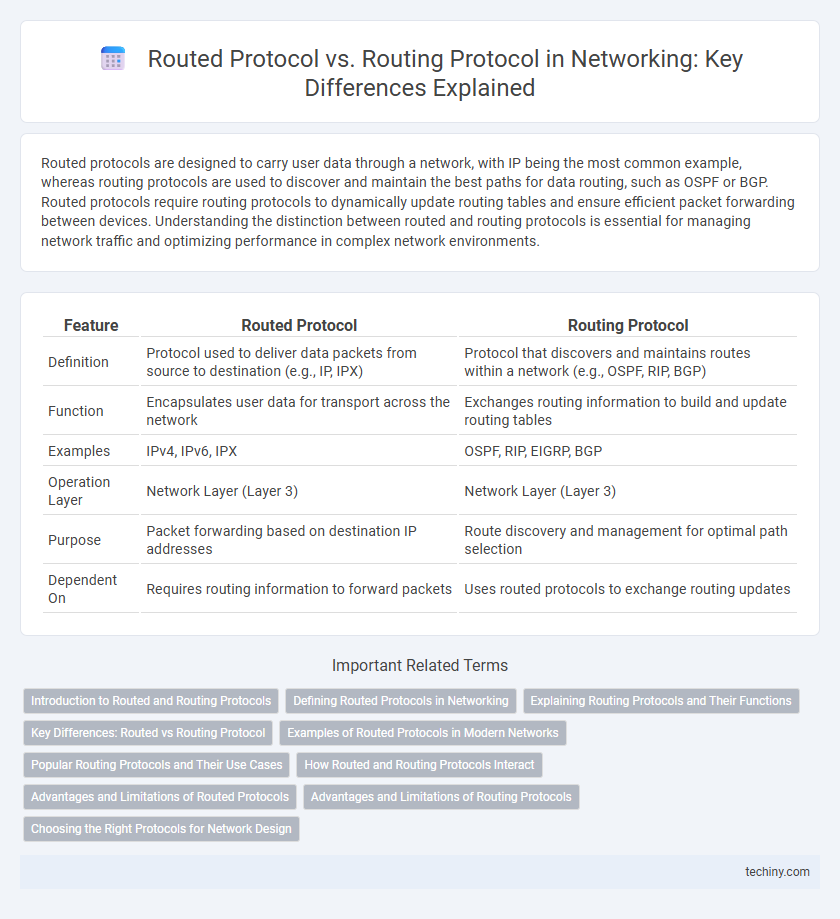Routed protocols are designed to carry user data through a network, with IP being the most common example, whereas routing protocols are used to discover and maintain the best paths for data routing, such as OSPF or BGP. Routed protocols require routing protocols to dynamically update routing tables and ensure efficient packet forwarding between devices. Understanding the distinction between routed and routing protocols is essential for managing network traffic and optimizing performance in complex network environments.
Table of Comparison
| Feature | Routed Protocol | Routing Protocol |
|---|---|---|
| Definition | Protocol used to deliver data packets from source to destination (e.g., IP, IPX) | Protocol that discovers and maintains routes within a network (e.g., OSPF, RIP, BGP) |
| Function | Encapsulates user data for transport across the network | Exchanges routing information to build and update routing tables |
| Examples | IPv4, IPv6, IPX | OSPF, RIP, EIGRP, BGP |
| Operation Layer | Network Layer (Layer 3) | Network Layer (Layer 3) |
| Purpose | Packet forwarding based on destination IP addresses | Route discovery and management for optimal path selection |
| Dependent On | Requires routing information to forward packets | Uses routed protocols to exchange routing updates |
Introduction to Routed and Routing Protocols
Routed protocols are network protocols that carry user data and can be assigned IP addresses, such as IP and IPX. Routing protocols, including OSPF, EIGRP, and RIP, enable routers to dynamically exchange routing information and determine optimal paths for data forwarding. Understanding the distinction between routed protocols, which define packet formats, and routing protocols, which dictate path selection processes, is essential for efficient network design and management.
Defining Routed Protocols in Networking
Routed protocols are network layer protocols that carry user data and can be assigned addresses, such as IP (Internet Protocol) and IPX (Internetwork Packet Exchange). These protocols facilitate the transmission of data packets by defining logical addressing schemes that enable devices to communicate across interconnected networks. In contrast to routing protocols, routed protocols are responsible for the actual delivery of the data, not the determination of the path taken.
Explaining Routing Protocols and Their Functions
Routing protocols facilitate the exchange of routing information between routers to determine optimal paths for data packets across networks. Common routing protocols include OSPF, BGP, and EIGRP, each employing specific algorithms like link-state or distance-vector to update and maintain routing tables dynamically. These protocols enable efficient path selection, network convergence, and scalability, essential for maintaining reliable communication within and between complex networks.
Key Differences: Routed vs Routing Protocol
Routed protocols, such as IP and IPX, are responsible for carrying user data through an internetwork by providing logical addressing and enabling packet forwarding. Routing protocols, including OSPF, EIGRP, and BGP, are used to discover, maintain, and update the paths or routes in a network dynamically. The key difference lies in that routed protocols encapsulate data for transmission, while routing protocols determine the best path for data delivery across interconnected networks.
Examples of Routed Protocols in Modern Networks
Examples of routed protocols in modern networks include Internet Protocol version 4 (IPv4), Internet Protocol version 6 (IPv6), and Internetwork Packet Exchange (IPX). Routed protocols enable the delivery of data packets from a source to a destination by carrying user traffic across network boundaries. These protocols operate at the network layer and require routing protocols such as OSPF, EIGRP, or BGP to determine optimal paths for data forwarding.
Popular Routing Protocols and Their Use Cases
Popular routing protocols such as OSPF, BGP, and EIGRP enable efficient path determination for data packets within and between networks, with OSPF commonly used in large enterprise environments for intra-domain routing, BGP serving as the backbone of internet routing by managing inter-domain traffic, and EIGRP favored in Cisco-dominated networks for its rapid convergence and scalability. Routed protocols like IP carry user data across networks, while routing protocols dynamically exchange routing information to update and maintain accurate routing tables. Understanding the use cases of these protocols is critical for optimizing network performance and ensuring reliable connectivity.
How Routed and Routing Protocols Interact
Routed protocols such as IP carry user data across networks, while routing protocols like OSPF and BGP determine the optimal paths for these packets by exchanging routing information between routers. Routing protocols update routing tables that routed protocols rely on to forward data packets efficiently across interconnected networks. The dynamic interaction between routed and routing protocols ensures accurate path selection and adapts to network topology changes in real-time.
Advantages and Limitations of Routed Protocols
Routed protocols, such as IP (Internet Protocol), enable the direct transmission of user data across diverse networks by defining logical addressing schemes, facilitating efficient end-to-end communication. Advantages of routed protocols include interoperability across multiple routing devices and scalability in large network environments. Limitations arise from their dependency on routing protocols for path determination and potential inefficiencies in dynamic topology changes without timely routing updates.
Advantages and Limitations of Routing Protocols
Routing protocols such as OSPF, EIGRP, and BGP enable dynamic path determination by exchanging routing information, which enhances network scalability and adaptability to topology changes. They provide automatic route updates and fault tolerance, reducing manual configuration errors and improving network resilience. However, limitations include increased CPU and memory usage on routers, potential routing loops without proper mechanisms, and the complexity of configuration and maintenance in large-scale networks.
Choosing the Right Protocols for Network Design
Routed protocols carry user data such as IP and enable packet forwarding across networks, while routing protocols determine the best path for data transmission by exchanging route information between routers. Selecting the appropriate routed and routing protocols depends on network size, scalability requirements, and specific application needs, with protocols like OSPF or EIGRP favored for large, complex environments and RIP suited for smaller networks. Optimizing network performance requires understanding protocol compatibility, convergence time, and resource consumption to ensure efficient data routing and robust connectivity.
Routed Protocol vs Routing Protocol Infographic

 techiny.com
techiny.com